At the biggest and busiest movie studio of Hollywood’s Golden Age, hummed the most productive studio wardrobe department in movie history. At its most complete in the 1960s, it had some 300,000 costumes in its wardrobe storage – not counting those it had already dicarded in previous decades. MGM regularly produced over 40 moves every year, with its costume designers and wardrobe department producing the costumes for most of them. By comparison, today’s studios make 10-15 movies a year, and of course studios no longer have in-house costume design and fabrication capabilities.
The facade of the old MGM Studio and its original entry gate on Washington Blvd as it looked in 1936 is seen above. The Wardrobe Department was located near Washington Blvd and what the studio called 1st Street. Men’s Wardrobe was located elsewhere and costumes were also stored in various locations. The Wardrobe Department had a manager who ran its day-to-day operations, separate from the costume design staff. A view to the three-story department is seen in the photo below. In addition to the glamorous part of movie costumes, post-production they would have to be laundered or dry-cleaned, and then inventoried and hung up in the high racks. Bolts of fabrics of all kinds would have to be kept on hand or custom ordered.
MGM went through several designers after its beginning in 1924-25. The studio hoped to capitalize on the name of Erte in 1925, but he didn’t last. Andre-Ani, Max Ree, and Rene Hubert all did fine work but none lasted long at the studio. Gilbert Clark managed to last longer, but was as temperamental as the divas he dressed. This didn’t work for Garbo. So when Cecil B. DeMille came to make movies for MGM and brought his costume designer Adrian, he soon found his designer under contract to MGM. Starting in 1928, every movie that Garbo starred in was designed by Adrian, as was every Joan Crawford movie until 1941 when Adrian left to start his own fashion line. He also designed the costumes for Jean Harlow, Hedy Lamarr, Lana Turner, and Katharine Hepburn.

Seen below is a group of MGM wardrobe ladies at work. The Adrian sketch shown and the costume on the dress form are for Greta Garbo in Grand Hotel. As was the case for all leading ladies, Garbo had her own custom-sized dress form (padded to her dimensions).
Hannah Lindfors, a cutter-fitter, is shown below. She translates the designer’s costume sketch into muslin pattern pieces, which are then used to cut the chosen fabric. In this case its for a Dolly Tree design for Rita Johnson. When Adrian left to start his own fashion business, Hannah Lindfors left with him as his cutter-fitter.
Several lace-makers are at work below on the bridal veil for Helen Hayes for the movie White Sister, 1933. It took two weeks to make.
Two Wardrobe ladies are working on the embroidery for a costume for Romeo and Juliet, starring Norma Shearer, Leslie Howard and John Barrymore. Adrian and Oliver Messel designed, and Wardrobe fabricated , some 1250 costumes for the film.
Cutter-fitter Inez Schrodt is seen below working on a gown for Marie Antoinette, 1938. The film starred Norma Shearer and Tyrone Power. Some 2500 costumes were used in the film, and Adrian designed 36 costumes for Norma, which was a long-standing record until Cleopatra of 1963.
Jane Halsey is seen below resting on a “leaning-board” during the filming of The Great Ziegfeld, 1936. The costume was made of bugle-beads and weighed 102 pounds. The leaning boards were heavily padded with cloth – less for comfort but as to prevent snags to the costumes.
Wardrobe ladies below are at work on Lana Turner’s costume in Ziegfeld Girl, 1941. The film had completely different but equally magnificent costumes as The Great Ziegfeld, which Adrian also designed.
Greer Garson has a stitch repair done to her costume by Vicky Nichols on the set of Mrs. Parkington, 1944. Her costumes were designed by Irene, who had taken over as head designer from Adrian. Irene was at MGM from 1942 until 1948. She was joined by Helen Rose and then Walter Plunkett. Irene Sharaff and Robert Kalloch also worked there for a period, and Gile Steele and J. Arlington Valles designed men’s costumes.
The Wardrobe Department kept most all of the costumes it made. These were re-used in other films, and often modified. Costumes are being pulled here and placed on a rack for some film. All of these costumes were sold in the MGM auction of 1970.
This section of shelving shows Roman style helmets, most likely with other armor pieces further inside the shelves. Similar but smaller shelves housed thousands of shoes.
Shelves and bins of shoes of all sizes and styles were also available for stock use. After years some of these were neglected and placed in more recessed areas, where no doubt the, several pairs of the Ruby Slippers from the Wizard of Oz were later found. Only one pair made its way to the MGM auction of 1970. It set the record for the highest priced item at the auction: $15,000. At recent auctions, pairs of the Ruby Slippers have fetched around $2 million.
Lana Turner is shown below with a costume sketch for one of her costumes and the actual costume from The Prodigal, 1955. Herschel McCoy designed the costumes for the film.
By 1955 when The Prodigal was produced by MGM, the heyday of the studio system was over. Leo B. Mayer had been replaced as head of the studio by Dore Schary. The Consent Decree forced by the US Court over an Anti-Trust suit had made studios divest their ownership of movie theaters, and television viewing had decimated movie audiences. Costume designers like Walter Plunkett, who had been working since the late 1920s, had gone from designing for over 20 movies a year back then to designing just two movies for MGM in 1957.
Fortunately, the legacy of MGM, its movies and the work of its costume designers and makers , and the other artists and artisans of the studio are preserved in the movies for all of us to see and enjoy. These behind the scenes photos show that the work of producing glamour was not glamorous. And in those days film credits did not acknowledge the work of any of them in wardrobe except for the costume designer. This is a small tribute to their work.
READ MORE ABOUT THE STUDIO WARDROBE DEPARTMENTS IN MY FORTHCOMING BOOK:


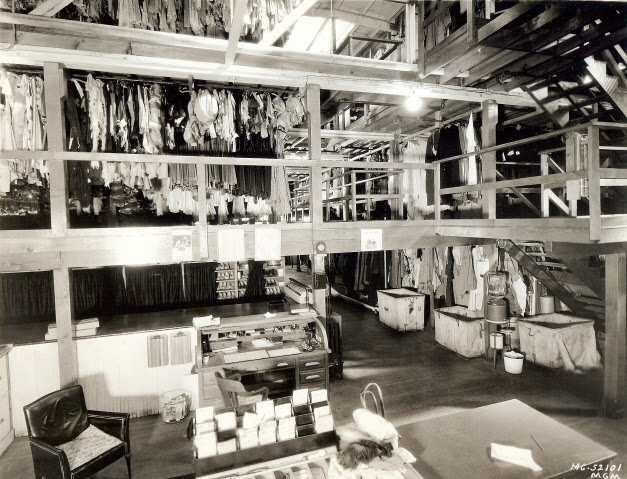



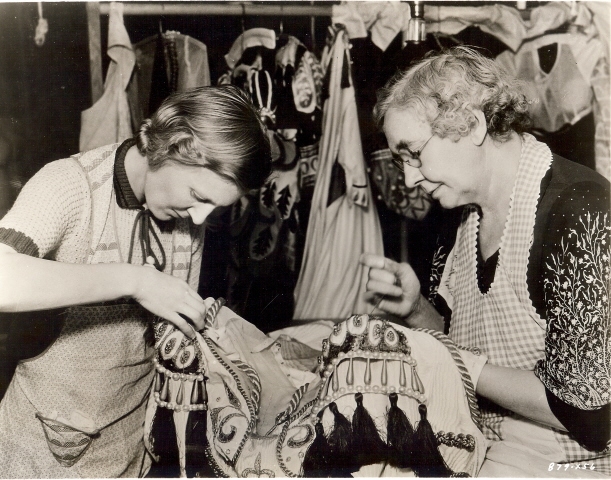


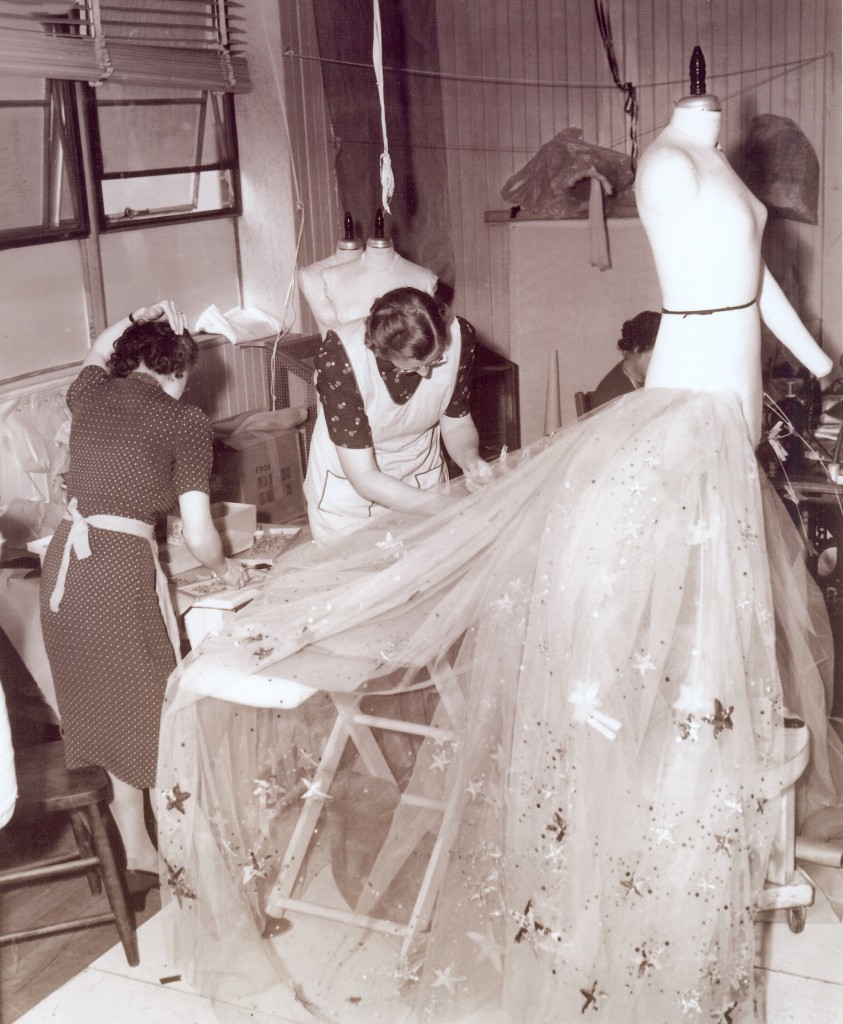
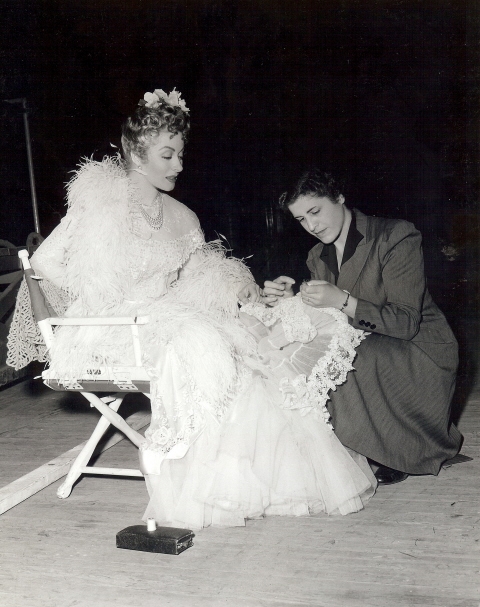
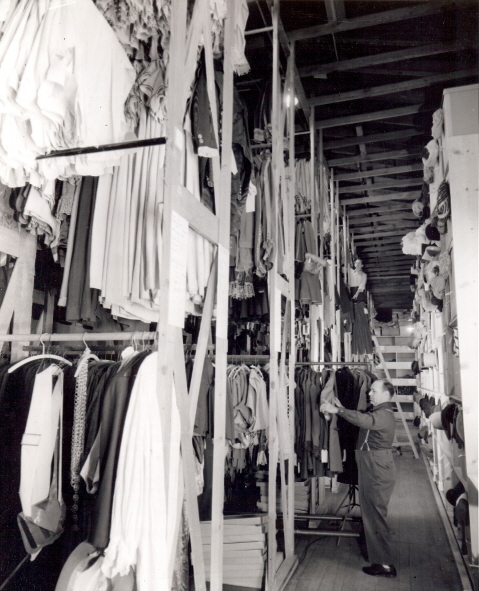
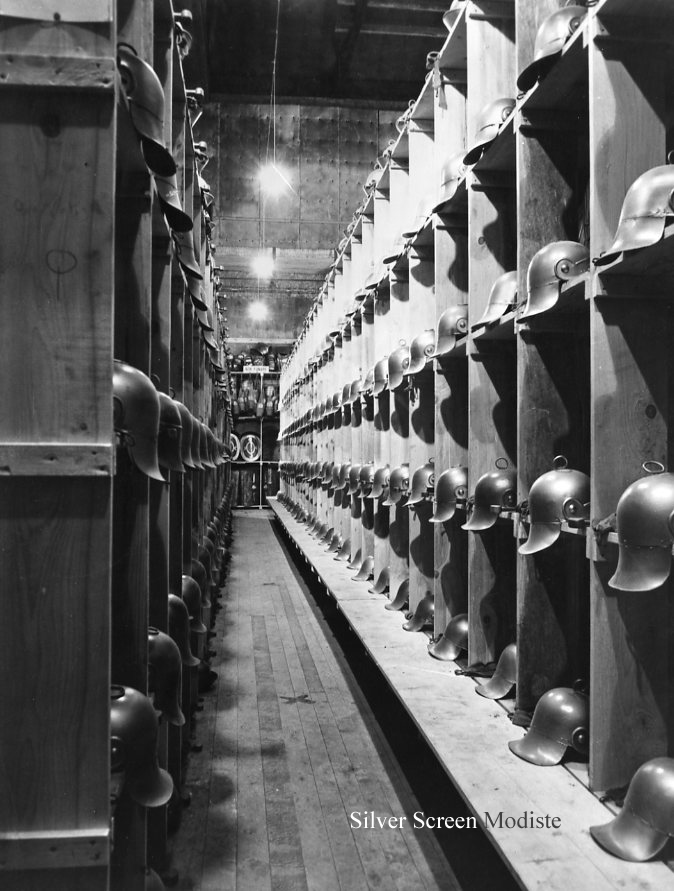


one relative of mine was Malbert Caplan. executive of MGM’s costume department from 1951 to 1969. I am looking for any stories, pictures, or information on him during this time at MGM
I recognize his name as head of wardrobe at M-G-M, but unfortunately I don’t have any information other than what you know, or photos, regrettably.
This is the best information I’ve been able to find so far in my investigation into the working lives of the makers behind the costumes. While there is so much out there about the designers and the costumes themselves, I haven’t been able to find much about the sewers, the cutters, the beaders, the fitters…not to mention the people working on set as wardrobe assistants. Thank you for this post. And if you have any suggestions where I might go sleuthing for the above-mentioned topics, I would be so grateful.
Thanks for your compliment Shelley. I have just finished a manuscript to be published next fall on the history of Hollywood studio wardrobe departments, their designers, stars, and staff like fitters, seamstresses, beaders, and costumers. Where I could find the information I named some of the behind the scenes wardrobe people that never got any credit. I’ll announce when the book comes out. There are many books that cover the designers, a glance through Amazon will reveal them, but so little about the women that fabricated the costumes. In the classic era they received no film credit and rarely any mention in the press. That’s one reason little is written about them – there is so little in research material. But I found some. Stay tuned – Christian
Hello
My aunt was one of the MGM seamstresses in the 30s. I’d love to see this book.
The book is excellent, and I understand a revised edition is coming out sometime soon. What was your aunt’s name?
Is my great grandmother listed in your book? Her name was Harriet Lapum Gibson or Ditzler.
I’m sorry but I did not run across your great-grandmother name in my research. Do you know what studio she worked for?
Love it, Mark! I use to be the costume designer in High School for the Plays at Granite Hills under Barry Bosworth’s direction believe it or not! I also just found out a year ago that one of my best baby friends Mom use to make the matching outfits for Judy Garland and her baby girl Liza!
Glad you enjoyed my blog post on M-G-M’s old wardrobe department. Your connections are very interesting. Thank you for sharing them.
Christian Esquevin, silverscreenmodes.com
Looking for photos of the Roman movie prop standards
sold by MGM in 1970 and in FoxI/II auctions in 1971.
Auction photos, or later displays such as at the Brucker
Buena Park California Movieword Museum are desired too.
oldflagswanted at att.net
Fascinating reading, thank you for your research and sharing the results. I do own a book called “MGM Hollywood’s Greatest Backlot” which I have read and read again, but I am still thirsty for knowledge of the finest film studio that ever existed.
Thank you for your comment and I’m glad you enjoyed the post. Of course the book you mention is very thorough and a wonderful resource on the subject, but I do include some photos not in the book.
GREAT pictures. For those of us that sew, it’s great to see people at work in the studio costuming areas. This is the first time I’ve every seen pictures such as these. Keep up the good work. Would love to see the inside of costumes. again for sewers, it would be fascinating.
I’m glad you enjoyed this post with its pictures. I wish they had taken photos of the insides of the classic Hollywood costumes, but I haven’t seen any, except sometimes the labels. Sometimes they come up for auction. If I get any photos I’ll try to post the.
Love this post! I’m fascinated with the early days of film costume design. I have been researching Gilbert Clark. He as working for Lucille, Ltd in London and came to he US to work for Lucille in about 1915/1916 (I find him on a passenger list as “Alfred Clark” “Designer.” In 1921 he opened his own store in Manhattan, “Gilbert Clark, Inc.” From there he became head costume deigner for Lasky’s Famous Player, then on to MGM and Paramount. He and Garbo did not get along. He worked on several/many films and designed some beautiful gowns, etc. After his last film in 1936, “Her Last Affaire”, from there he drops out of sight. Any chance you have any info on him? I’m thinking he went back to London but don’t have hard evidence. Such as an obituary! Thanks for your informative post!
I’m glad you liked this post Patti. Gilbert Clark is not credited with any costume designs after 1935. He appears to have died in Los Angeles in 1977. I don’t currently have access to the index to the Los Angeles Times, but he may have appeared in that newspaper subsequently, or an obituary may have have been written of him. If I find any information I’ll repost at this spot.
This post is a treasure. I look forward to reading further.
Hi
Did MGM really sell lots of things before the big auction? I have always been curious about this.
Hi Dean.No MGM didn’t sell items at auction prior to their big 1970 auction. They had disposed of older wardrobe costumes, however, in the 1930s. Adrian himself had complained about this. One can imagine the beautiful (but then out-of-date) flapper dresses and coats being dumped.
Great stuff, Christian. Remember the auction? 1969 or 70. I both wanted to go and wept. As always, you have captured the essence of the Golden years, and, in particular the backbreaking work of the behind the scenes people like seamstresses, fitters, pressers etc. Hearts and flowers to you!
Thank you for your comments and compliments Inge. All those wardrobe workers in the back rooms contributed so much to the quality of the films. My great-aunt was one of them, the cutter-fitter at RKO. And yes, the MGM auction was in 1970. Many of the unidentified costumes were priced at $1.00 each.
Awesome! Considering I’m on this lot every week now, you know I love this!
Thanks Kimberly! I actually have many photos of the lot, outdoor sets, shots inside the sound stages during productions, and views of the various trades at work during the Golden Age. They are endlessly fascinating. But of course the Wardrobe Dept has a special interest. But did you know MGM had a zoo? Or a barber shop? Or ran a school? Or had its own lumber mill? A tour back then would have been fun.
Fascinating. Love these photos. It really was a world unto itself, wasn’t it?
Thanks for the comment Jacqueline – it was like a behive. But a world all of itself as you say – a real factory of dreams because you can see that the surroundings are humble. The money all went into the production, although the workers were paid decently, and the ones with skills were paid very well.
Terrific post on the behind-the-scene activities associated with MGM’s wardrobe department. Love the photos, too. If movies back then showed all the credits, as they do now, can you imagine how lengthy some of the credits would have been?
Thanks Rick. Actually, I think the credits would be shorter because there wouldn’t be all the outside services – like the caterers getting film credit for example, or the 6th co-producer’s 3rd assistant.